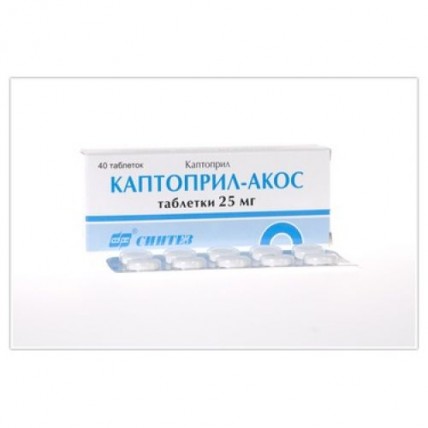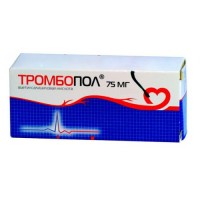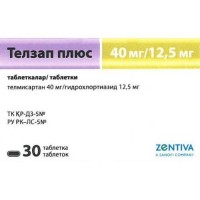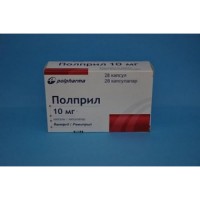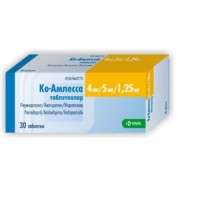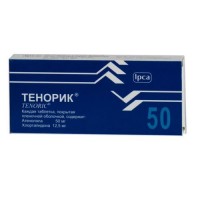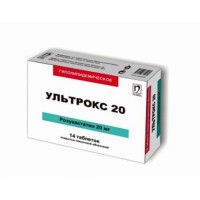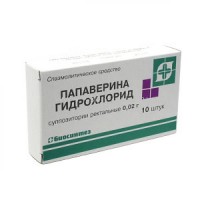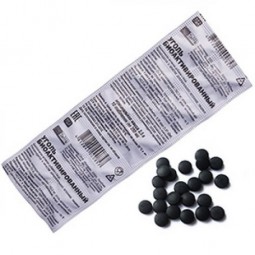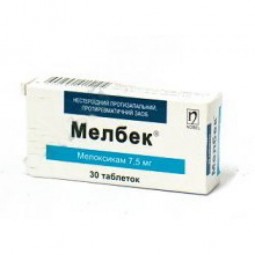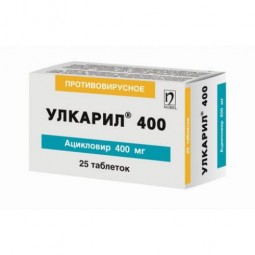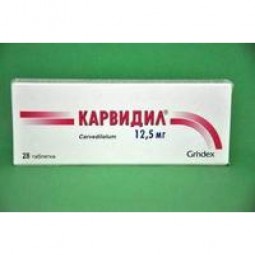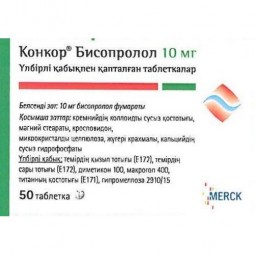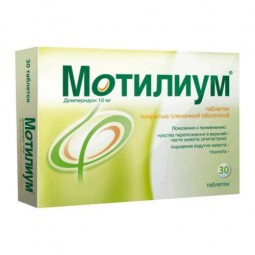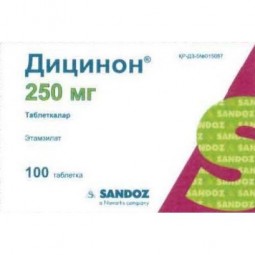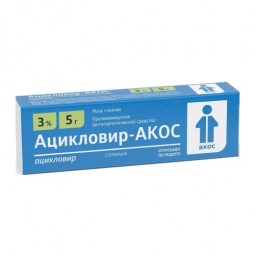Captopril-Akos 25 mg (40 tablets)
- $2.60
The instruction
for medical use
of KAPTOPRIL-AKOS medicine
the Trade name
of KAPTOPRIL-AKOS
the International unlicensed
name Captopril Dosage Form
of the Tablet, 25 mg
Structure on one tablet
One tablet contains
active agent – captopril
(in terms of dry matter) 25 mg,
excipients: lactose, starch corn, talc, magnesium stearate
the Description
of the Tablet of color, white or white with a creamy shade, with a characteristic smell, a ploskotsilindrichesky form with a facet. Easy marbling
Pharmacotherapeutic group
of Angiotenzinkonvertiruyushchy enzyme (AKF) inhibitor
the Code of automatic telephone exchange C09AA01
the Pharmacological
Pharmacokinetics Absorption properties – fast is allowed, reaches 75% (meal lowers by 30-40%), bioavailability – 35-40% (effect of the first passing through a liver). Communication with proteins of blood plasma (mainly with albumine) – 25-30%, the maximum concentration in blood plasma (114 ng/ml) at intake – 30-90 min. Through a blood-brain barrier and a placental barrier gets badly (less than 1%). The dimeasure of captopril and captopril-tsisteindisulfida is metabolized in a liver with education disulfide. Metabolites pharmacological are inactive. Elimination half-life makes 3 h. It is removed generally by kidneys (95%, 40-50% in not changed look, the rest in the form of metabolites). Cosecretes with maternal milk. In 4 h after single dose inside urine contains 38% of not changed captopril and 28% in the form of metabolites, in 6 h – only in the form of metabolites, in daily urine – 38% of not changed captopril and 62% - in the form of metabolites. Elimination half-life at the broken renal function – 3.5-32 h Kumuliruyet in chronic kidney disease.
The pharmacodynamics
Reduces formation of an angotenzin of II of an angotenzin of I. Decrease in maintenance of an angotenzin of II leads to direct reduction of discharge of Aldosteronum. At the same time the general peripheric vascular resistance, arterial blood pressure, post- and preload of heart decreases. Expands arteries more than veins. Causes bradykinin degradation reduction (one of effects of APF) and increase in synthesis of prostaglandin. The hypotensive effect does not depend on activity of renin of plasma, the lowering of arterial pressure is noted at the normal and even reduced level of hormone that is caused by impact on fabric system renin-angiotenzinovye. Strengthens a coronary and renal blood stream. At prolonged use reduces expressiveness of a hypertrophy of a myocardium and walls of arteries of resistive type. Improves blood supply of an ischemic myocardium. Reduces aggregation of thrombocytes. Promotes decrease in maintenance of ions of sodium (Na+) at patients with chronic heart failure. The lowering of arterial pressure unlike direct vazodilatator (a gidralazin, a minoksidil and so forth) is not followed by reflex tachycardia and leads to decrease in need of a myocardium for oxygen. In heart failure in an adequate dose does not influence the size of arterial blood pressure. The maximum lowering of arterial pressure after intake is observed in 60-90 min. Duration of hypotensive effect of a dozozavisim also reaches optimum values within several weeks.
Indications
- arterial hypertension, including renovascular
- chronic heart failure (as a part of complex therapy)
- dysfunction of a left ventricle after the postponed myocardial infarction at clinically stable state
- a diabetic nephropathy against the background of diabetes of the I type (at an albuminuria more than 30 mg/days)
appoint the Route of administration and doses of Kaptopril-AKOS inside in 1 hour prior to food. The mode of dosing is set individually. At titration of a dose of drug captopril on the stated indications it is necessary to use captopril in a dosage form: tablets on 12.5 mg.
In arterial hypertension treatment there begin with the smallest effective dose 12.5 mg 2 times a day (rarely from 6.25 mg 2 times a day). It is necessary to pay attention to shipping of the first dose within the first hour. If at the same time arterial hypotension developed, the patient it is necessary to turn to horizontal position (such reaction to the first dose should not serve as an obstacle to further therapy). If necessary the dose gradually (at an interval of 2-4 weeks) is increased before achievement of optimum effect. In soft or moderate arterial hypertension the usual maintenance dose makes 25 mg 2 times a day, the maximum dose – 50 mg 2 times a day. In heavy arterial hypertension the maximum dose – 50 mg 3 times a day. The maximum daily dose – 150 mg.
At elderly patients the initial dose makes 6.25 mg 2 times a day.
In chronic heart failure appoint together with diuretics and/or in a combination with foxglove drugs (in order to avoid an initial excessive lowering of arterial pressure, before purpose of Kaptoprila-AKOS diuretic is cancelled or reduce a dose). The initial dose makes 6.25 mg or 12.5 mg 3 times a day, if necessary the dose is increased gradually (with intervals not less than 2 weeks) to 25 mg by 2-3 times a day. The maximum daily dose makes 150 mg.
At dysfunctions of a left ventricle after the postponed myocardial infarction at the patients who are in clinically stable state, use of Kaptoprila-AKOS can be begun in 3 days after a myocardial infarction. The initial dose makes 6.25 mg/days, then the daily dose can be increased within several weeks up to 37.5-75 mg for 2-3 receptions (depending on tolerance of drug). If necessary the dose is gradually increased to the maximum daily dose – 150 mg/days (on 50 mg 3 times a day). At development of arterial hypotension the dose decline can be required. The subsequent attempts of use of the maximum daily dose of 150 mg have to be based on shipping sick Kaptoprila-AKOS.
At a diabetic nephropathy appoint in a daily dose 75-100 mg/days for 2-3 receptions. In insulin-dependent diabetes with a microalbuminuria (discharge of albumine of 30-300 mg a day) the dose of drug makes 50 mg 2 times a day. At the general clearance of protein more than 500 mg a day drug is effective in a dose of 25 mg 3 times a day.
At moderate degree of a renal failure (the clearance of creatinine (CC) – not less than 30 ml/min. / 1.73 the sq.m) Kaptopril-AKOS can appoint 75-100 mg/days in a dose. At more expressed degree of renal failures (KK – less than 30 ml/min. / 1.73 sq.m) the initial dose has to make no more than 12.5 mg/days, further, if necessary, the dose of Kaptoprila-AKOS is gradually raised through rather long intervals of time, but use smaller, than in case of treatment of arterial hypertension, a daily dose of drug. If necessary appoint loopback diuretics, but not diuretics of a thiazide row.
Side effects
- orthostatic hypotension, tachycardia, peripheral hypostases
- dry cough, a bronchospasm, a fluid lungs
- the Quincke's disease of extremities, persons, lips, mucous membranes, language, a throat or a throat is observed at patients at use of inhibitors of the angiotensin-converting enzymes (ACE), including Captopril (if puffiness is limited to a face and lips, such state usually passes after drug phase-out, for simplification of clinical symptoms antihistaminic drugs can be used, patients have to be under observation of the doctor before disappearance of symptoms if hypostasis covers language, a throat or a throat with threat of development of obstruction of airways, it is necessary to make a subcutaneous injection of adrenaline (0.5 ml, 1:1000))
- a hyperpotassemia (it is most probable in a renal failure)
- a hyponatremia (most often at a saltless diet and simultaneous use of diuretics)
- a proteinuria, the increased urea nitrogen content in blood, creatinine
- acidosis
- in rare instances a neutropenia, an agranulocytosis, thrombocytopenia and anemia (at patients with normal function of kidneys (clearance of creatinine & lt, 1.6 mg/dl) in the absence of other complicating factors the neutropenia was observed in 0.02% cases, was in rare instances reported about positive test for antibodies to nuclear antigen)
- reversible and usually independently undergoing disturbance of sense of taste, dryness in a mouth, stomatitis, reminding aphthous sores, increase in activity of enzymes of a liver
- seldom abdominal pain, diarrhea
- a hyperplasia of gums
- hepatitis, increase in level of hepatic transaminases in blood plasma and a hyperbilirubinemia
- rash, usually followed by an itching and in rare instances fervescence (as a rule, it is easy, temporary, makulezno-papular character, seldom reminds a small tortoiseshell and disappears within several days after a drug dose decline, symptomatic treatment by antihistaminic drugs, can be required drug withdrawal)
- inflows, vesicular or bullous rashes, an erythema (including Stephens-Johnson's syndrome) and a photosensitization
- a headache, dizziness, an ataxy, paresthesias, drowsiness
- other:
the Contraindication disorder of vision
- hypersensitivity to drug and other APF inhibitors
- a Quincke's disease (against the background of use of APF inhibitors, including in the anamnesis)
- the profound renal failures or a liver
- a hyperpotassemia
- a bilateral stenosis of renal arteries or a stenosis of an artery of the only kidney with the progressing azotemia
- a state after transplantation of a kidney
- the stenosis of the mouth of an aorta and similar changes complicating blood outflow
- pregnancy and the period of a lactation
- teenage age (up to 18 years)
Medicinal interactions
Increases concentration of digoxin in blood plasma by 15-20%. Increases bioavailability of propranolol. Cimetidinum, slowing down metabolism in a liver, increases concentration of captopril in blood plasma. The hypotensive effect is weakened by non-steroidal anti-inflammatory drugs (NPVP) (Na delay + and decrease in synthesis of prostaglandin), especially against the background of low concentration of renin, and estrogen (Na+ delay). A combination with thiazide diuretics, vazodilatator (minoksidit), verapamil, beta blockers, tricyclic antidepressants, ethanol enhances hypotensive effect. The combined use with kaliysberegayushchy diuretics (for example, Triamterenum, Spironolactonum, amiloride), potassium drugs, cyclosporine, milk with the low content of salts (may contain K+ to 60 mmol/l), potassium additives, salt substitutes (contain significant amounts of K+) increases risk of development of a hyperpotassemia. Slows down removal of drugs of lithium. Simultaneous use of salts of lithium and inhibitors of the angiotensin-converting enzyme (ACE) can lead to increase in concentration of lithium in blood serum. At the same time the risk of emergence of side and toxic effects of drugs of lithium increases. Removal of drug through kidneys decreases against the background of Probenetsid.
When prescribing captopril against the background of intake of Allopyrinolum or procaineamide, risk of development of a syndrome of Stephens-Johnson and immunodepressive effect increases. Use of captopril for the patients accepting immunodepressants (for example, Azathioprinum or cyclophosphamide), increases risk of development of hematologic disturbances.
Special instructions
With care: to apply in a serious autoimmune illness (especially system lupus erythematosus or a system scleroderma), oppression of a marrowy hemopoiesis (risk of development of a neutropenia and an agranulocytosis), brain ischemia, diabetes (risk of development of a hyperpotassemia), at patients, being on a hemodialysis, primary hyper aldosteronism, coronary heart disease, states, followed by decrease in volume of the circulating blood (including diarrhea, vomiting is increased), at advanced age.
With care appoint the patient who is on a low-salt or saltless diet (the increased risk of developing arterial hypotension) and a hyperpotassemia.
Before the beginning and also regularly in the course of treatment of Kaptoprilom-AKOS it is necessary to control function of kidneys. At patients with chronic heart failure drug is used under careful medical control. Against the background of prolonged use of Kaptoprila-AKOS approximately at 20% of patients the stable increase in urea and creatinine of blood serum more than for 20%, in comparison with norm or a reference value is observed. Less than at 5% of patients, especially at heavy nefropatiya, the termination of treatment because of growth of concentration of creatinine is required.
At patients with arterial hypertension at use of Kaptoprila-AKOS, the profound arterial hypotension is observed only in rare instances, the likelihood of development of this state raises at deficit of loss of liquid and salts (for example, after intensive treatment by diuretics), at patients with chronic heart failure or being on dialysis. The possibility of a sharp lowering of arterial pressure can be minimized at preliminary cancellation (in 4-7 days) diuretic, or by prescribing of captopril in an initiation of treatment in small doses (6.25-12.5 mg/days).
In the first 3 months of therapy monthly control number of leukocytes of blood, further – 1 time in 3 months: at patients with autoimmune diseases in the first 3 months – in each 2 weeks, then – each 2 months. If the number of leukocytes are lower 4000/mkl, performing the general blood test is shown, below 1000/mkl – administration of drug is stopped.
In certain cases against the background of use of APF inhibitors, including captopril, increase in potassium concentration in blood serum is observed. Risk of development of a hyperpotassemia at use of APF inhibitors is increased at the patients with a renal failure and diabetes and also accepting the kaliysberegayushchy diuretics, drugs of potassium or other drugs causing increase in potassium concentration in blood (for example, heparin). It is necessary to avoid simultaneous use of kaliysberegayushchy diuretics and drugs of potassium.
When carrying out a hemodialysis at the patients receiving Kaptopril-AKOS it is necessary to avoid use of dialysis membranes with high-permeability (for example, AN69) as in such cases the risk of development of anaphylactoid reactions increases. In case of development of a Quincke's disease, drug is cancelled and carry out careful medical observation and symptomatic therapy.
At reception of Kaptoprila-AKOS the false positive reaction can be observed in the analysis of urine on acetone.
The feature of influence of medicine on ability to run the vehicle or potentially dangerous mechanisms
during treatment needs to abstain from driving of motor transport and occupations potentially dangerous types of activity demanding the increased concentration of attention and speed of psychomotor reactions since dizziness, especially after reception of an initial dose is possible.
Overdose
Symptoms - the profound lowering of arterial pressure, up to collapse, a myocardial infarction, an acute disorder of cerebral circulation, tromboembolic episodes.
Treatment - to lay the patient with the raised lower extremities, the measures directed to restoration of arterial blood pressure (increase in volume of the circulating blood, including in/in injection of 0.9% of solution of sodium of chloride), symptomatic therapy. Use of a hemodialysis, peritoneal dialysis is possible – it is not effective.
Form of release and packing
of the Tablet, 25 mg.
On 10 tablets in blister strip packaging.
On 2 or 4 blister strip packagings together with the instruction for medical use in the state and Russian languages place in a pack from cardboard.
To Store storage conditions in the dry place at a temperature not above 25 °C
to Store in the places inaccessible for children!
Not to apply a period of storage of 5 years after an expiration date.
Prescription status
According to the prescription
JSC Sintez Producer.
Russian Federation, 640008, Kurgan, Konstitutsii Avenue, 7.
ph./fax (3522) 48-16-89
The owner of the registration certificate
of JSC Sintez, the Russian Federation
the Address of the organization accepting in the territory of the Republic of Kazakhstan claims from consumers on quality of products (goods)
of STOFARM LLP,
000100, Republic of Kazakhstan, Kostanay region, Kostanay, Uralskaya St., 14
ph. 714 228 01 79
To develop
for medical use
of KAPTOPRIL-AKOS medicine
the Trade name
of KAPTOPRIL-AKOS
the International unlicensed
name Captopril Dosage Form
of the Tablet, 25 mg
Structure on one tablet
One tablet contains
active agent – captopril
(in terms of dry matter) 25 mg,
excipients: lactose, starch corn, talc, magnesium stearate
the Description
of the Tablet of color, white or white with a creamy shade, with a characteristic smell, a ploskotsilindrichesky form with a facet. Easy marbling
Pharmacotherapeutic group
of Angiotenzinkonvertiruyushchy enzyme (AKF) inhibitor
the Code of automatic telephone exchange C09AA01
the Pharmacological
Pharmacokinetics Absorption properties – fast is allowed, reaches 75% (meal lowers by 30-40%), bioavailability – 35-40% (effect of the first passing through a liver). Communication with proteins of blood plasma (mainly with albumine) – 25-30%, the maximum concentration in blood plasma (114 ng/ml) at intake – 30-90 min. Through a blood-brain barrier and a placental barrier gets badly (less than 1%). The dimeasure of captopril and captopril-tsisteindisulfida is metabolized in a liver with education disulfide. Metabolites pharmacological are inactive. Elimination half-life makes 3 h. It is removed generally by kidneys (95%, 40-50% in not changed look, the rest in the form of metabolites). Cosecretes with maternal milk. In 4 h after single dose inside urine contains 38% of not changed captopril and 28% in the form of metabolites, in 6 h – only in the form of metabolites, in daily urine – 38% of not changed captopril and 62% - in the form of metabolites. Elimination half-life at the broken renal function – 3.5-32 h Kumuliruyet in chronic kidney disease.
The pharmacodynamics
Reduces formation of an angotenzin of II of an angotenzin of I. Decrease in maintenance of an angotenzin of II leads to direct reduction of discharge of Aldosteronum. At the same time the general peripheric vascular resistance, arterial blood pressure, post- and preload of heart decreases. Expands arteries more than veins. Causes bradykinin degradation reduction (one of effects of APF) and increase in synthesis of prostaglandin. The hypotensive effect does not depend on activity of renin of plasma, the lowering of arterial pressure is noted at the normal and even reduced level of hormone that is caused by impact on fabric system renin-angiotenzinovye. Strengthens a coronary and renal blood stream. At prolonged use reduces expressiveness of a hypertrophy of a myocardium and walls of arteries of resistive type. Improves blood supply of an ischemic myocardium. Reduces aggregation of thrombocytes. Promotes decrease in maintenance of ions of sodium (Na+) at patients with chronic heart failure. The lowering of arterial pressure unlike direct vazodilatator (a gidralazin, a minoksidil and so forth) is not followed by reflex tachycardia and leads to decrease in need of a myocardium for oxygen. In heart failure in an adequate dose does not influence the size of arterial blood pressure. The maximum lowering of arterial pressure after intake is observed in 60-90 min. Duration of hypotensive effect of a dozozavisim also reaches optimum values within several weeks.
Indications
- arterial hypertension, including renovascular
- chronic heart failure (as a part of complex therapy)
- dysfunction of a left ventricle after the postponed myocardial infarction at clinically stable state
- a diabetic nephropathy against the background of diabetes of the I type (at an albuminuria more than 30 mg/days)
appoint the Route of administration and doses of Kaptopril-AKOS inside in 1 hour prior to food. The mode of dosing is set individually. At titration of a dose of drug captopril on the stated indications it is necessary to use captopril in a dosage form: tablets on 12.5 mg.
In arterial hypertension treatment there begin with the smallest effective dose 12.5 mg 2 times a day (rarely from 6.25 mg 2 times a day). It is necessary to pay attention to shipping of the first dose within the first hour. If at the same time arterial hypotension developed, the patient it is necessary to turn to horizontal position (such reaction to the first dose should not serve as an obstacle to further therapy). If necessary the dose gradually (at an interval of 2-4 weeks) is increased before achievement of optimum effect. In soft or moderate arterial hypertension the usual maintenance dose makes 25 mg 2 times a day, the maximum dose – 50 mg 2 times a day. In heavy arterial hypertension the maximum dose – 50 mg 3 times a day. The maximum daily dose – 150 mg.
At elderly patients the initial dose makes 6.25 mg 2 times a day.
In chronic heart failure appoint together with diuretics and/or in a combination with foxglove drugs (in order to avoid an initial excessive lowering of arterial pressure, before purpose of Kaptoprila-AKOS diuretic is cancelled or reduce a dose). The initial dose makes 6.25 mg or 12.5 mg 3 times a day, if necessary the dose is increased gradually (with intervals not less than 2 weeks) to 25 mg by 2-3 times a day. The maximum daily dose makes 150 mg.
At dysfunctions of a left ventricle after the postponed myocardial infarction at the patients who are in clinically stable state, use of Kaptoprila-AKOS can be begun in 3 days after a myocardial infarction. The initial dose makes 6.25 mg/days, then the daily dose can be increased within several weeks up to 37.5-75 mg for 2-3 receptions (depending on tolerance of drug). If necessary the dose is gradually increased to the maximum daily dose – 150 mg/days (on 50 mg 3 times a day). At development of arterial hypotension the dose decline can be required. The subsequent attempts of use of the maximum daily dose of 150 mg have to be based on shipping sick Kaptoprila-AKOS.
At a diabetic nephropathy appoint in a daily dose 75-100 mg/days for 2-3 receptions. In insulin-dependent diabetes with a microalbuminuria (discharge of albumine of 30-300 mg a day) the dose of drug makes 50 mg 2 times a day. At the general clearance of protein more than 500 mg a day drug is effective in a dose of 25 mg 3 times a day.
At moderate degree of a renal failure (the clearance of creatinine (CC) – not less than 30 ml/min. / 1.73 the sq.m) Kaptopril-AKOS can appoint 75-100 mg/days in a dose. At more expressed degree of renal failures (KK – less than 30 ml/min. / 1.73 sq.m) the initial dose has to make no more than 12.5 mg/days, further, if necessary, the dose of Kaptoprila-AKOS is gradually raised through rather long intervals of time, but use smaller, than in case of treatment of arterial hypertension, a daily dose of drug. If necessary appoint loopback diuretics, but not diuretics of a thiazide row.
Side effects
- orthostatic hypotension, tachycardia, peripheral hypostases
- dry cough, a bronchospasm, a fluid lungs
- the Quincke's disease of extremities, persons, lips, mucous membranes, language, a throat or a throat is observed at patients at use of inhibitors of the angiotensin-converting enzymes (ACE), including Captopril (if puffiness is limited to a face and lips, such state usually passes after drug phase-out, for simplification of clinical symptoms antihistaminic drugs can be used, patients have to be under observation of the doctor before disappearance of symptoms if hypostasis covers language, a throat or a throat with threat of development of obstruction of airways, it is necessary to make a subcutaneous injection of adrenaline (0.5 ml, 1:1000))
- a hyperpotassemia (it is most probable in a renal failure)
- a hyponatremia (most often at a saltless diet and simultaneous use of diuretics)
- a proteinuria, the increased urea nitrogen content in blood, creatinine
- acidosis
- in rare instances a neutropenia, an agranulocytosis, thrombocytopenia and anemia (at patients with normal function of kidneys (clearance of creatinine & lt, 1.6 mg/dl) in the absence of other complicating factors the neutropenia was observed in 0.02% cases, was in rare instances reported about positive test for antibodies to nuclear antigen)
- reversible and usually independently undergoing disturbance of sense of taste, dryness in a mouth, stomatitis, reminding aphthous sores, increase in activity of enzymes of a liver
- seldom abdominal pain, diarrhea
- a hyperplasia of gums
- hepatitis, increase in level of hepatic transaminases in blood plasma and a hyperbilirubinemia
- rash, usually followed by an itching and in rare instances fervescence (as a rule, it is easy, temporary, makulezno-papular character, seldom reminds a small tortoiseshell and disappears within several days after a drug dose decline, symptomatic treatment by antihistaminic drugs, can be required drug withdrawal)
- inflows, vesicular or bullous rashes, an erythema (including Stephens-Johnson's syndrome) and a photosensitization
- a headache, dizziness, an ataxy, paresthesias, drowsiness
- other:
the Contraindication disorder of vision
- hypersensitivity to drug and other APF inhibitors
- a Quincke's disease (against the background of use of APF inhibitors, including in the anamnesis)
- the profound renal failures or a liver
- a hyperpotassemia
- a bilateral stenosis of renal arteries or a stenosis of an artery of the only kidney with the progressing azotemia
- a state after transplantation of a kidney
- the stenosis of the mouth of an aorta and similar changes complicating blood outflow
- pregnancy and the period of a lactation
- teenage age (up to 18 years)
Medicinal interactions
Increases concentration of digoxin in blood plasma by 15-20%. Increases bioavailability of propranolol. Cimetidinum, slowing down metabolism in a liver, increases concentration of captopril in blood plasma. The hypotensive effect is weakened by non-steroidal anti-inflammatory drugs (NPVP) (Na delay + and decrease in synthesis of prostaglandin), especially against the background of low concentration of renin, and estrogen (Na+ delay). A combination with thiazide diuretics, vazodilatator (minoksidit), verapamil, beta blockers, tricyclic antidepressants, ethanol enhances hypotensive effect. The combined use with kaliysberegayushchy diuretics (for example, Triamterenum, Spironolactonum, amiloride), potassium drugs, cyclosporine, milk with the low content of salts (may contain K+ to 60 mmol/l), potassium additives, salt substitutes (contain significant amounts of K+) increases risk of development of a hyperpotassemia. Slows down removal of drugs of lithium. Simultaneous use of salts of lithium and inhibitors of the angiotensin-converting enzyme (ACE) can lead to increase in concentration of lithium in blood serum. At the same time the risk of emergence of side and toxic effects of drugs of lithium increases. Removal of drug through kidneys decreases against the background of Probenetsid.
When prescribing captopril against the background of intake of Allopyrinolum or procaineamide, risk of development of a syndrome of Stephens-Johnson and immunodepressive effect increases. Use of captopril for the patients accepting immunodepressants (for example, Azathioprinum or cyclophosphamide), increases risk of development of hematologic disturbances.
Special instructions
With care: to apply in a serious autoimmune illness (especially system lupus erythematosus or a system scleroderma), oppression of a marrowy hemopoiesis (risk of development of a neutropenia and an agranulocytosis), brain ischemia, diabetes (risk of development of a hyperpotassemia), at patients, being on a hemodialysis, primary hyper aldosteronism, coronary heart disease, states, followed by decrease in volume of the circulating blood (including diarrhea, vomiting is increased), at advanced age.
With care appoint the patient who is on a low-salt or saltless diet (the increased risk of developing arterial hypotension) and a hyperpotassemia.
Before the beginning and also regularly in the course of treatment of Kaptoprilom-AKOS it is necessary to control function of kidneys. At patients with chronic heart failure drug is used under careful medical control. Against the background of prolonged use of Kaptoprila-AKOS approximately at 20% of patients the stable increase in urea and creatinine of blood serum more than for 20%, in comparison with norm or a reference value is observed. Less than at 5% of patients, especially at heavy nefropatiya, the termination of treatment because of growth of concentration of creatinine is required.
At patients with arterial hypertension at use of Kaptoprila-AKOS, the profound arterial hypotension is observed only in rare instances, the likelihood of development of this state raises at deficit of loss of liquid and salts (for example, after intensive treatment by diuretics), at patients with chronic heart failure or being on dialysis. The possibility of a sharp lowering of arterial pressure can be minimized at preliminary cancellation (in 4-7 days) diuretic, or by prescribing of captopril in an initiation of treatment in small doses (6.25-12.5 mg/days).
In the first 3 months of therapy monthly control number of leukocytes of blood, further – 1 time in 3 months: at patients with autoimmune diseases in the first 3 months – in each 2 weeks, then – each 2 months. If the number of leukocytes are lower 4000/mkl, performing the general blood test is shown, below 1000/mkl – administration of drug is stopped.
In certain cases against the background of use of APF inhibitors, including captopril, increase in potassium concentration in blood serum is observed. Risk of development of a hyperpotassemia at use of APF inhibitors is increased at the patients with a renal failure and diabetes and also accepting the kaliysberegayushchy diuretics, drugs of potassium or other drugs causing increase in potassium concentration in blood (for example, heparin). It is necessary to avoid simultaneous use of kaliysberegayushchy diuretics and drugs of potassium.
When carrying out a hemodialysis at the patients receiving Kaptopril-AKOS it is necessary to avoid use of dialysis membranes with high-permeability (for example, AN69) as in such cases the risk of development of anaphylactoid reactions increases. In case of development of a Quincke's disease, drug is cancelled and carry out careful medical observation and symptomatic therapy.
At reception of Kaptoprila-AKOS the false positive reaction can be observed in the analysis of urine on acetone.
The feature of influence of medicine on ability to run the vehicle or potentially dangerous mechanisms
during treatment needs to abstain from driving of motor transport and occupations potentially dangerous types of activity demanding the increased concentration of attention and speed of psychomotor reactions since dizziness, especially after reception of an initial dose is possible.
Overdose
Symptoms - the profound lowering of arterial pressure, up to collapse, a myocardial infarction, an acute disorder of cerebral circulation, tromboembolic episodes.
Treatment - to lay the patient with the raised lower extremities, the measures directed to restoration of arterial blood pressure (increase in volume of the circulating blood, including in/in injection of 0.9% of solution of sodium of chloride), symptomatic therapy. Use of a hemodialysis, peritoneal dialysis is possible – it is not effective.
Form of release and packing
of the Tablet, 25 mg.
On 10 tablets in blister strip packaging.
On 2 or 4 blister strip packagings together with the instruction for medical use in the state and Russian languages place in a pack from cardboard.
To Store storage conditions in the dry place at a temperature not above 25 °C
to Store in the places inaccessible for children!
Not to apply a period of storage of 5 years after an expiration date.
Prescription status
According to the prescription
JSC Sintez Producer.
Russian Federation, 640008, Kurgan, Konstitutsii Avenue, 7.
ph./fax (3522) 48-16-89
The owner of the registration certificate
of JSC Sintez, the Russian Federation
the Address of the organization accepting in the territory of the Republic of Kazakhstan claims from consumers on quality of products (goods)
of STOFARM LLP,
000100, Republic of Kazakhstan, Kostanay region, Kostanay, Uralskaya St., 14
ph. 714 228 01 79
To develop
